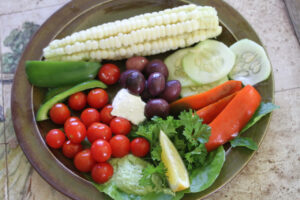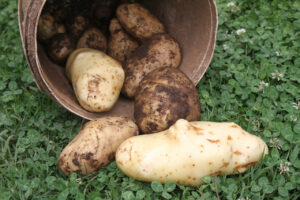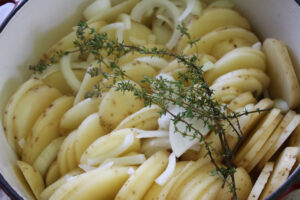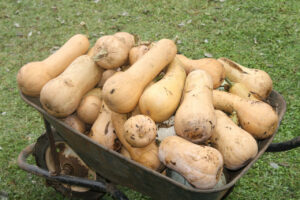 Starches form the foundation of most people’s diets, rich and poor alike; at least a third and often far more. Yet they have become the new whipping boy in both the popular and scientific press; they make us fat and cause type-2 diabetes. Or do they?
Starches form the foundation of most people’s diets, rich and poor alike; at least a third and often far more. Yet they have become the new whipping boy in both the popular and scientific press; they make us fat and cause type-2 diabetes. Or do they?
First it was animal fat, after researcher Radley Keys cooked the books, causing the world to eschew eggs, dairy products and meat and to turn to mainly refined starches primarily for food. Now the heart foundation actually recommends eating eggs, despite their cholesterol.
Very little distinction is made between refined and whole carbs; all have been placed together in one basket of contempt.
But it is refined cereals, cake flour, mealiemeal, sugar and white rice, that primarily have caused the very worrying surge in obesity and diabetes, and the attendant non-communicable diseases that cause far more deaths, even in the midst of the pandemic; more than two to one according to the World Health Organisation.
There is powerful research confirming that significant weight loss has much greater benefits for diabetics than lowering blood sugar, blood pressure and cholesterol. Big questions about starches in general remain though; the jury is not yet out.

It is also these refined starches that are in large measure causing what is being called the “slow violence of malnutrition,” especially in South Africa, but in reality over most of the world. With all the goodness having been removed by milling companies, food companies then turn them into cheap food that really should not be called food at all. No farmer would feed his chickens or cattle on refined mealiemeal or cake flour, yet we gladly give it to our children and eat it ourselves. Four million children in South Africa are permanently stunted, mentally and/or physically according to the Children’s Resource Centre.
Furthermore, it is these refined starches that cause the surge in blood glucose that leads directly to the non-communicable conditions like diabetes and cardiovascular disease. The extraction of the bran and germ from grains which is where the fibre, protein, healthy fats, minerals and vitamins are found is one of the chief causes of this malnutrition and stunting.
On the other hand, the research literature is also overwhelmingly in favour of whole grains and legumes, both rich in “resistant starch.” The difficulty is that whole grains are increasingly difficult to get and society would far rather eat meat, eggs and cheese than pulses, the edible seeds of legumes like peas, beans and lentils, despite the cost.
So, grow a mountain of starch in your own garden; unrefined they are the chief source of energy, many important minerals and vitamins needed in the body. There is absolutely no reason why anyone with a small piece of ground need be overwhelmed by talk of “food insecurity” and the rising prices of refined foods.
There are many whole starches that the home gardener can easily grow. Here just four have been chosen; maize, potatoes, butternut and susu.

Mealies
Maize is the chief grain grown in South Africa and it is easily and inexpensively planted in the home garden. It is eaten regularly by more than half the population anyway, but mostly as super-refined mealiemeal. It’s doubtful that even one in ten regularly enjoys the whole grain as “corn on the cob;” that does not affect blood glucose negatively, nor cause obesity. The yellow varieties have more lutein and zeaxanthin, the phytochemicals proven to help prevent macular degeneration.
Researchers Brennan and Kuri found that consumer preference is based on sensory perceptions, rather than nutritional value; colour, taste, aroma, texture and fineness. There was a “moderate dislike” rating for hammer-mill maize due to its coarseness. White maize was significantly preferred. There was a much higher preference for white super-fortified maizemeal. The whiter and finer, the more it was liked.
Education stands firmly at the centre of better health and well-being; having become accustomed to refined grains, it remains a huge challenge to re-educate society that these foods are the cause of the epidemic of obesity and type-2 diabetes that is gripping South Africa. And an even greater challenge to persuade food companies and retailers to start providing whole grains, far less profitable to them, as an alternative. Every town should, as of old, have a mill providing freshly-ground mealiemeal daily.

Mealies are easy to grow. Draw a line in the earth, drop in a cheap, open-pollinated seed every 20cm, rake over the soil and wait for the heavens to water and God to give the growth; every plant is a miracle of good food unfolding.
We started this series with the importance of water; an underground reservoir that harvests and stores the rain is where all this begins. An excessively dry period when the maize is in flower can ruin everything, and municipal water is expensive, unreliable and increasingly polluted.
In a future article, there will be discussion of compost heaps and worm farms. Maize is a heavy feeder and demands either expensive inorganic fertilisers, or a pile of home-produced humus.

Potatoes
Before discussing how to grow a mountain of potatoes in the home garden, two important principles should be explained. Potatoes from cold storage are highly glycemic; they are fattening particularly when deep fried or boiled.
Retrogradation is what happens to starches that are cooked, and then cooled, and if necessary reheated the following day. The long chains of glucose units rearrange themselves into a form that is more difficult for the enzymes in the gut to digest; the sugars are released more gradually. In effect, cooling overnight turns a rapidly-digested starch into one that is slowly broken down in the intestine.
In practical terms this means cooking your spuds the day before serving a potato salad, and cooling it overnight in the fridge; some aforethought is necessary.
And secondly, new potatoes have about half the glycemic load, and they have a much lower GI; the structure of the starch is different making it more difficult for the enzymes to produce a blood-sugar rush. In short, they are a slowly-digested starch.

The smaller the new potato, the lower the GI. There is a simple test whether the spud in your hand is new or not; scrape your thumbnail over the skin and it readily peels off.
So to summarise, only those who grow their own potatoes, and are prepared to cool them overnight before consumption can eat them with confidence. Commercially new potatoes are hard to find, and are very expensive. Lift only enough for a few days.
There is one other reason to grow and enjoy your own new potatoes; commercially they are sprayed with paraquat just before harvesting to kill off the haulm. It’s a herbicide so toxic that it is completely banned in Europe.
The green garden is frequently plagued by moles; they too know the benefits of living in an environment free from pesticides. Do not plant your seed potatoes in trenches; instead set them in holes about 40cm deep; first lay some coarse material such as mealie stalks at the bottom, then rich compost and a little wood ash. Set a short stake such as a bamboo stick in each hole, and then heap up the soil as the haulm emerges, the higher the better. Using dry leaves for a mulch is beneficial; never newly-mown green grass.

Butternut
Butternut squash is another source of low-glycemic starch; it has a GI of only 51 depending on how it is cooked. Roasting raises the glycemic index, cooling overnight followed by reheating causes the amylose to retrograde, just as with potato.
Interestingly, before the discovery of insulin, small amounts (to reduce the overall glycemic load) of the pumpkin family were used in many cultures in the treatment of diabetes; it’s a slow release starch which on reaching the colon is devoured by the microflora producing short-chain fatty acids that reduce inflammation in the body in general, but in this instance in the pancreas in particular.
Retain one corner of the compost heap for planting butternut seeds in Spring, saved from the fruit when enjoyed in late autumn and winter. It is not unusual to produce dozens of giant squash, which unlike some fruit, do not lose their flavour when very large. In a glut the excess can be readily cooked and frozen.
Butternut soup, often with added sweet potato, spices and coconut cream is a favourite with many, keeping for nearly a week and providing ready meals of retrograded low-glycemic starch.
It is a particularly rich source of beta-carotene, the precursor of vitamin A; worldwide nearly half a million children annually go blind because of vitamin A deficiency. It also has an important role in the prevention of macular degeneration.

Susu squash
Known in much of the world as chayote, this rather tasteless squash is abhorred by many, yet it is very easy to grow in the green garden producing fifty or more of the fruit, and is a rich source of very low-glycemic starch; the load is particularly low with only 6 grams of carbs per cup, much of it fibre. It is rich in many minerals and important phytochemicals, folate and vitamin C.
Those who love it, use it either raw and marinaded overnight in a salad, or gently fried in olive oil with hot peppers and garlic. It makes an excellent filler for soups and stews.
In early winter the fruit hanging on the vine starts to produce a shoot; pick the gourd and plant it two-thirds underground, the top part and shoot above the earth. It best grown under a small tree which the vine will use for support; it is prolific.
Anecdotally it provides great relief for those suffering from heartburn at night.
Wheat, oats and barley
Small grains like wheat, oats and barley are difficult to reap and process for the homesteader; yet they too are a rich source of resistant starch and many extremely important phytochemicals. In a separate essay will discuss interesting subjects such as bread baked with 100% wholemeal, milky oats, barley tea, and perhaps even beer.
Healthy, nutritious low GI starches can readily be grown in the home garden; they are not fattening and in moderation can be enjoyed by the obese and most diabetics. They are true functional foods, promoting health and helping in the fight against disease.
Conversely, refined starches are the devil; they promote inflammation, weight gain and insulin resistance and should be strictly limited by all who wish to enjoy long and healthy lives, largely free from non-communicable diseases and medication. They are at the very centre of what is being called the double burden of malnutrition; high levels of obesity alongside stunting and wasting.
Corn and beans complement each other, giving the full spectrum of essential amino acids. In the next essay in this series we will consider the starch and protein in legumes.
Hippocrates, the Father of Medicine, is much hallowed but generally ignored; let your food be your medicine and medicine your food. All should be followers of this great man’s dictum. Growing a mountain of non-glycemic starch in our own gardens would be a significant start; hunger would be banished.
By Barrie Lewis



Leave a Reply or Follow